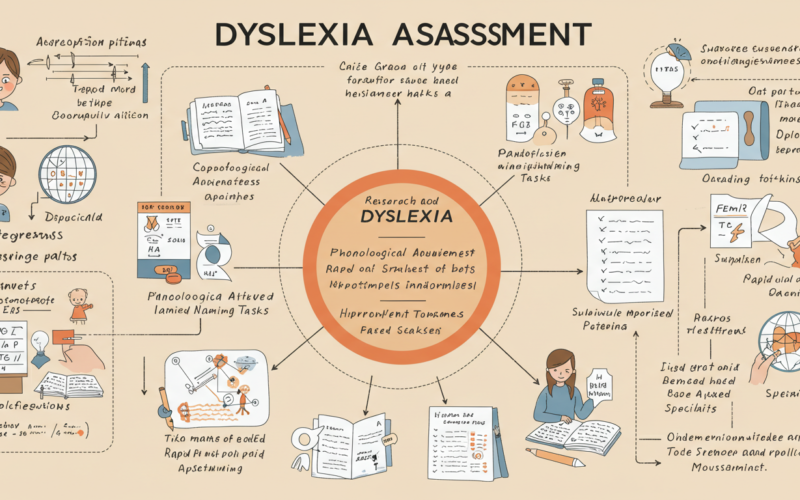Dyslexia is a learning difference that affects 15-20% of all people, making reading, writing, and spelling more challenging.
The first step in proper dyslexia intervention is effective assessment. Recent research highlights some of the best practices for identifying and evaluating dyslexia.
Comprehensive Evaluation
A truly thorough dyslexia assessment needs to include multiple measures. These can include standardized tests, observations, and background information from parents and teachers.
According to the International Dyslexia Association, a high-quality evaluation must assess phonological processing, reading fluency, spelling, and reading comprehension. By collecting data from various sources, professionals can better understand a child’s strengths and weaknesses.
Linguistic Risk Factors
In a WPS Dyslexia webinar, reading expert Dr. Nancy Mather explained how phonological awareness, rapid automatized naming (RAN), and orthographic processing are all strong indicators of dyslexia. Other risk factors include processing speed, working memory, and visual-verbal paired associate learning (PAL).
A study published in the Journal of Learning Disabilities (Duff et al., 2022) found that kids who struggle with such skills in the earlier grades are at a significantly higher risk for having reading difficulties later on. That’s why assessments must include tasks that measure these cognitive functions, otherwise they hinder early detection.
Early Screening and Intervention
The earlier we can identify dyslexia, the more effective interventions can be. A review from the American Academy of Pediatrics found that children who receive intervention before second grade ultimately show more reading gains than those identified later on (Sanfilippo et al., 2020).
Screening tools like the Tests of Dyslexia (TOD™) can be early indicators of reading difficulties. They let educators intervene before the achievement gaps grow too wide.
The Tests of Dyslexia (TOD)
The TOD was designed to assess reading and language difficulties in individuals between the ages of 5 and 89. The test evaluates core reading processes like phonemic awareness, word recognition, and reading comprehension.
It’s impossible to overemphasize the importance of early and accurate diagnosis, and the TOD meets that need. It’s highly effective in diagnosing dyslexia and helps guide intervention strategies. Professionals who incorporate TOD into their evaluations can be assured of a thorough and research-supported assessment.
Dyslexia Myths
Despite scientific advancements and continuing education on the topic, myths about dyslexia still exist. A study by Durham University found that nearly half of teachers and therapists still believe falsehoods, such as dyslexia is a visual distortion like reversing letters (Daniel et al., 2024). Tests, therefore, need to be grounded in neuroscience and literacy research, not based on old myths. That way, families and individuals can avoid misdiagnoses.
Individualized Assessments
No two people with dyslexia are the same since the condition presents differently in everyone. That means professionals must have flexible assessment strategies.
According to the International Dyslexia Association, a dyslexia assessment should identify the learning difficulty and help determine what type of specific support each person needs (Woodcock, 2024). Otherwise, a one-size-fits-all approach could overlook more unique learning profiles. That’s why individualized testing is so important for planning effective interventions.
Research-Driven Evaluations
Dyslexia assessments need to be research-driven and comprehensive. They also need to be adaptable.
The TOD and other evidence-based tools help educators and clinicians accurately identify different reading difficulties and develop targeted interventions. When they understand best assessment practices, students are assured of receiving the support they need early on, which improves their literacy outcomes.
You can learn more about how assessment tools can help kids in school by visiting WPS.
Research and Resources:
International Dyslexia Association. (2015, June 11). Testing and Evaluation. https://dyslexiaida.org/testing-and-evaluation/
Duff, D. M., Hendricks, A. E., Fitton, L., & Adlof, S. M. (2022). Reading and Math Achievement in Children with Dyslexia, Developmental Language Disorder, or Typical Development. Journal of Learning Disabilities. https://doi.org/10.1177/00222194221105515
Sanfilippo J, Ness M, Petscher Y, Rappaport L, Zuckerman B, Gaab N. (2020) Reintroducing Dyslexia: Early Identification and Implications for Pediatric Practice. American Academy of Pediatrics. 2020 https://doi.org/10.1542/peds.2019-3046
Daniel, J., Clucas, L., & Wang, H.-H. (2024). Identifying Students with Dyslexia: Exploration of Current Assessment Methods. Annals of Dyslexia. https://link.springer.com/article/10.1007/s11881-024-00313-y



